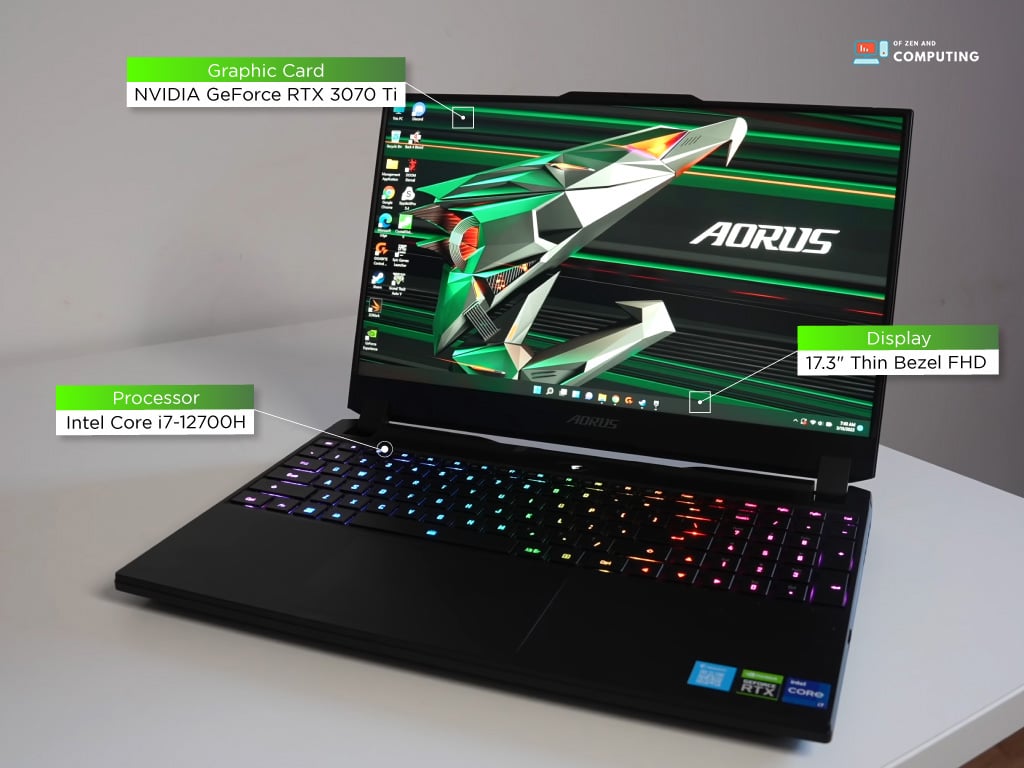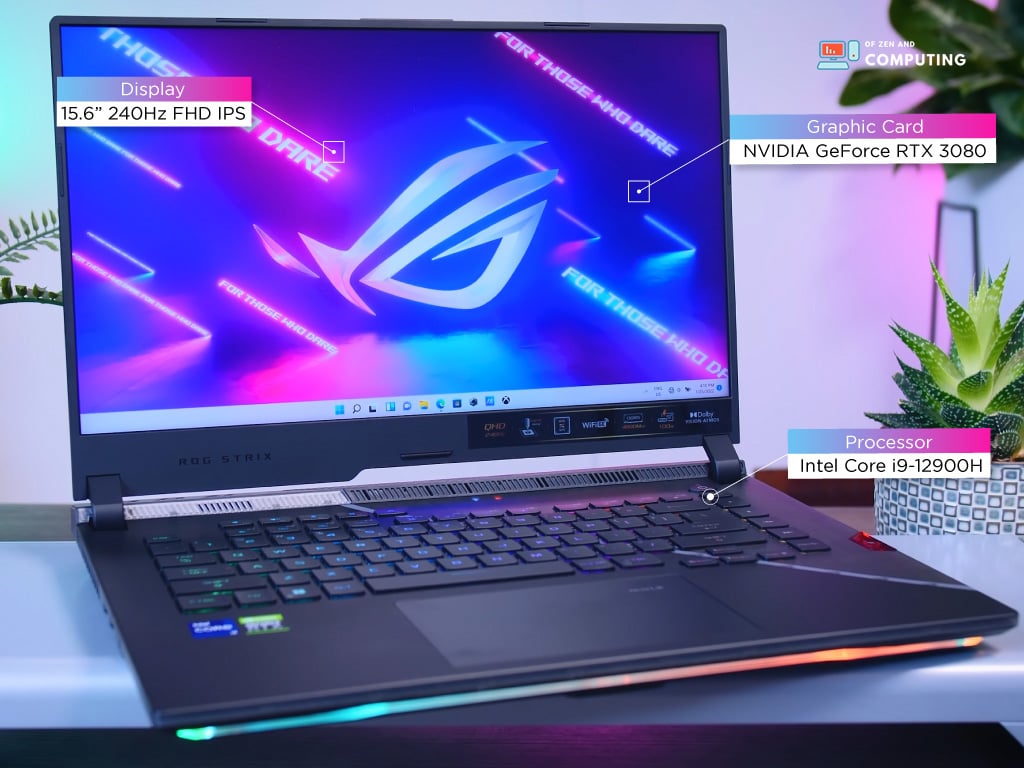10 Best Gaming Laptops Under $2000 2024 [13th Gen Updated]
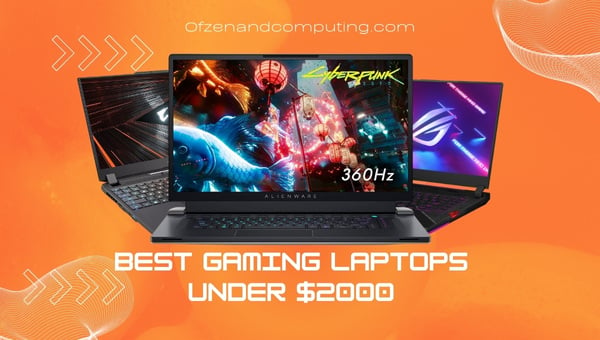
Gaming technology has come a long way in the last few years. While PCs and gaming consoles are more powerful than ever, the new generation of gaming laptops has entirely changed the gaming world.
With modern high-performance processors like the 13th-gen Intel i7 and i9 and advanced graphic cards, gaming laptops can offer stellar gaming performance with high-definition graphics and an immersive gaming experience.
As the title says, in this article, we’ll be going through some of the best gaming laptops under $2000 available on the market in 2024. But if you can increase your budget by $500 and get the best gaming laptop under $2500, as all the models just got their 2024 update.
Now, keep in mind that while gaming laptops can go much higher in price, $2000 is a substantial amount and can get you a high-performance gaming laptop no matter what anyone tells you.
That being said, there are lots of factors other than the budget that you need to consider when you buy a gaming laptop. So before we get to our list of the best gaming laptops under $2000, let’s look at these.
Skip to
10 Best Gaming Laptops Under $2000 In 2024
For hardcore gamers looking for a laptop that can handle the most demanding games, this list of 10 best gaming laptops under $2000 in 2024 provides great value machines with enough power to get through any game without breaking the bank.
| IMAGE | LAPTOP | BUY NOW |
|---|---|---|
GIGABYTE AORUS 15
|
||
ASUS ROG Strix Scar 15
|
||
Razer Blade 14
|
||
HP OMEN 16
|
||
Alienware X17 R2
|
||
Sager NP7881D
|
||
ASUS TUF F15
|
||
MSI Rainbow 6
|
||
Lenovo LOQ
|
||
Acer Predator
|
These are perfect if you’re looking to upgrade your gaming experience. So, without further ado, let’s get straight to it.
1. GIGABYTE AORUS 15
Screen: 17.3″ Thin Bezel FHD 1920×1080 IPS-level Anti-glare Cutting-Edge Display (360Hz, 72% NTSC) | CPU: Intel Core i7-12700H (2.3GHz~4.7GHz) | Graphics: NVIDIA GeForce RTX 3070 Ti Laptop GPU 8GB GDDR6, Boost Clock 1410MHz, Maximum Graphics Power 130W | RAM: 16GB DDR4 3200 8GB*2, 2x DDR4 Slots – Max 64GB | Storage: 1TB Storage NVMe SSD | Ports: 1x Thunderbolt 4, 1x HDMI 2.1, 1x USB 3.2 Gen1 (Type-C with DP), 1x USB 3.2 Gen1 (Type-A), 1x RJ45, 1x Audio Combo Jack, 1x DC-in | Speaker: 2x 2W Speakers, DTS X Ultra Audio | Weight: 5.29 pounds
Imagine a gaming laptop that can handle all your gaming fantasies, malfunctioning heartbreakingly on the second day, yet you would still swear by it; well, that was the first roller-coaster ride I had with this bad boy.
Priced rather affordably at $1,749, this marvel houses a host of mind-blowing specs. Before we dive into my experience with the laptop itself, let’s have a little chat about its specifications.
Decked up with a sleek and thin bezel FHD 1920×1080 IPS-level Anti-glare display, this piece of tech marries form and function with absolute grace.
But what really caught my attention was its Intel Core i7-12700H CPU. I could literally feel the difference as the laptop runs smoothly without a hitch, even on graphics-intensive games.
Speaking of graphics, nothing can beat its NVIDIA GeForce RTX 3070 Ti Laptop GPU – every game feels utterly immersive because of it.
Let me cut to the chase- the GIGABYTE AORUS 15 handles every game I’ve thrown at it like a boss. The modern AAA games? It’s absolutely smooth, with a frame rate floating between 80-90 FPS.
Now, that’s what I call an impressive performance! On the flip side, it wasn’t all sunshine and sprinkles. A minor setback was the noisy fans, which, although managed to keep things cool, were a bit of a turn-off.
Now, here’s where it gets interesting. Many might view its battery power as its Achilles heel — only living through 2 hours of unplugged action.
However, if you’re anything like me, who continually keeps their laptop plugged in during gaming sessions, then it really isn’t much of an issue.
Life is not without its ironies, and my sweet journey with this laptop hit a rough patch right on day two! Suddenly, out of nowhere, came forth the dreaded Blue Screen of Death, putting my dear AORUS into boot cycle limbo.
Was it disappointing? Heck yes! But we soldiered on, and I got it fixed under warranty.
Our Verdict
GIGABYTE AORUS 15 is certainly not without flaws, but honestly – no showstopper here (barring the second-day hiccup!). Jam-packed with powerful specs, promising impressive gaming performance, but yes, folks – do keep that charger handy!
Pros And Cons
- Smooth gaming performance
- Upgradeable specs
- High-quality display
- Short battery life
- Potential software glitches
2. ASUS ROG Strix Scar 15
Screen: 15.6” Quad HD (2560 x 1440) 240Hz 3ms IPS Type Display with 100% DCI-P3 | CPU: Intel Core i9 12900H (2.50GHz) 24M Cache, up to 5GHz, 14 cores (6 P-cores and 8 E-cores) | Graphics: NVIDIA GeForce RTX 3070 Ti 16GB GDDR6 | RAM: 32GB DDR5 4800MHz RAM | Storage: 1TB PCIe 4.0 NVMe M.2 Performance SSD | Ports: 1 x USB 3.2 Gen 2 Type-C support DisplayPort / power delivery / G-SYNC, 2 x USB 3.2 Gen 1 Type-A, 1 x Thunderbolt 4 support DisplayPort, 1 x HDMI 2.1, 1 x RJ-45 (2.5Gbps), 1 x 3.5mm Combo Audio Jack | Speaker: 2 x 4W speakers | Weight: 5.07 pounds
In the sweeping world of gaming laptops, ASUS ROG Strix Scar 15 confidently stands its ground with an impressive arsenal punching well under the $2000 mark. I’ve had the pleasure of taking this beast for a spin, and my experience was mostly rewarding.
Right off the bat, let’s delve into those tantalizing specs. Sporting a 15.6” Quad HD display boasting an amazing 240Hz refresh rate, ASUS ROG Strix Scar 15 ensures that your gaming universe is crisp and smoothly flowing without a glitch.
For long gaming grinds and binge-watching sprees, trust me, your eyes will thank you.
Now, here’s where things start to get really interesting. Powering the laptop is none other than Intel’s latest i9 powerhouse CPU with an astounding count of 14 cores, which ensures tasks are tackled with great ease and agility.
Let’s not forget that remarkable NVIDIA GeForce RTX 3070 Ti Graphics card; I could take on VR Games like Boneworks or blade and Sorcery, as well as consistently stressful titles like Red Dead Redemption II or Warzone at Ultra settings without a hitch.
Alongside its stellar performance in games, it handles other intensive tasks deftly, too – all thanks to its sizable pool of 32GB DDR5 RAM and generous storage provided by its lightning-fast 1TB PCIe SSD.
Behind all these beefy aspects lies its impressive assortment of ports consisting of various types, including USB Type-C HDMI, among others.
My personal favorite is the Thunderbolt port – it’s extremely handy during impromptu LAN parties as it supports DisplayPort functionality. All these are packed neatly in a robust yet lightweight chassis weighing only around five pounds; astonishingly portable indeed.
My journey with this laptop was not without bumps. After certain driver updates, some annoying lines began appearing on the lower part of my screen, causing quite some concern.
Despite exhausting every fix in my tech troubleshooting handbook, I was left with no other option but to reach out to ASUS.
In what happened to be less than an ideal customer experience, I was told that the laptop needed an RMA that may take up to two months; certainly a hassle one would not want with a $2000 gadget.
Our Verdict
Despite this hurdle, I must say my overall experience with the ASUS ROG Strix Scar 15 was largely positive. It shines as a top-notch gaming machine with killer specs and handy features.
Weighing the pros and cons, it is undoubtedly one of the better options within this price bracket.
Pros And Cons
- Spectacular Gaming Performance
- High-refresh rate display
- Portable design with generous connectivity
- High-capacity RAM and storage
- Potential display issues
- Higher price tag
3. Razer Blade 14
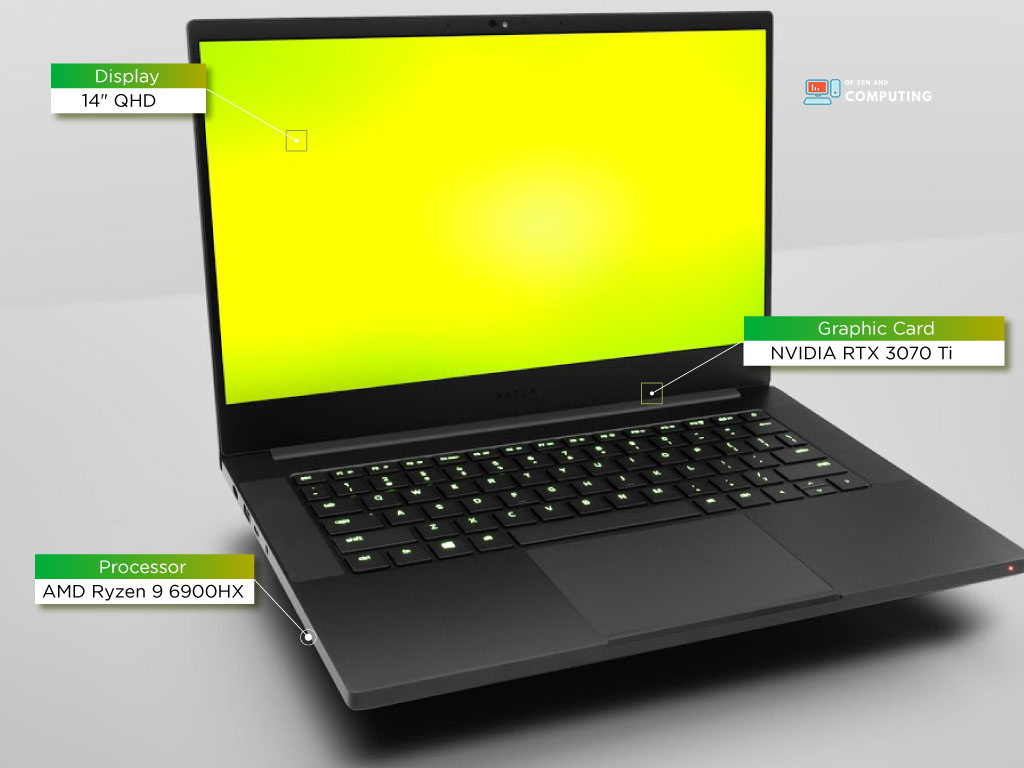
Screen: 14″ QHD 1920 x 1080 display, up to 100% sRGB, 165Hz refresh rate, thin bezel | CPU: AMD Ryzen 9 6900HX 8 Core, 3.3GHz Base, 4.6GHz Max Boost | Graphics: NVIDIA GeForce RTX 3070 Ti 8GB GDDR6 | RAM: 16GB DDR5 | Storage: 1TB SSD | Ports: 2 x USB Type-A, 1 x HDMI 2.0, 2 x USB Type-C Display Port 1.4, 1 x Gigabit Ethernet, 3.5mm Combo Audio, Kensington Lock | Speaker: 2.1 stereo speakers | Weight: 3.92 pounds
Before I delve into the nitty-gritty, let’s take a quick look at the specs of the Razer Blade 14. Priced at $1,999, this gaming laptop comes with a 14″ QHD, 1920 x 1080 display that boasts up to 100% sRGB and a refresh rate of 165Hz.
It utilizes an AMD Ryzen 9 processor with an NVIDIA GeForce RTX 3070 Ti Graphics card to ensure smooth gaming experiences no matter what you throw at it.
This laptop has ample storage with its 1TB SSD and a practical collection of ports for any need. Plus, it’s quite portable with its slim build and weight of just under four pounds.
Now, onto the real fun stuff – my personal experience with this device. The most visually striking element when unboxing the Razer Blade was the sleek design.
Considering its price point, I expected no less than perfection in appearance and feel right out of the box.
For Me as someone who appreciates even the smallest details when it comes to tech, I found features like a fan positioned right underneath WASD keys refreshing.
After all, who wouldn’t appreciate cooler keys during intense gaming sessions? On the downside, though – bright green details were a bit too much for me personally.
The piece-de-resistance here is definitely its performance; quite honestly- it can handle just about anything you put in its path without sweating – one might say it runs hot.
Graphics-heavy games run smoothly without any hiccups thanks to its powerful CPU and GPU combo.
Navigating this machine is made effortless due to its compact footprint – making it perfect for gaming on the go. However, as splendid as the Razer Blade sounds thus far – there’s one glaring issue that has dampened my overall love for this machine: Its Keyboard.
As a content creator & gamer alike, typing on Razer Blade was not the most inspiring experience. The keyboard often played havoc with my sentences and made it difficult to maneuver characters fluidly in games like Insurgency Sandstorm.
If you intend on using this laptop for purposes that require a lot of typing, such as content creation or social media, an external keyboard might be a worthwhile investment.
Our Verdict
The Razer Blade 14 offers uncompromised performance wrapped in a gorgeous design. Despite the keyboard falling short of users’ expectations – if you have gaming as your top priority and plenty of coins to spare – this laptop might be worth your consideration.
Pros And Cons
- Powerful performance
- Compact, aesthetically pleasing design
- Great color accuracy with 100% sRGB
- Keyboard is unreliable
- Could use fewer bright green details
4. HP OMEN 16
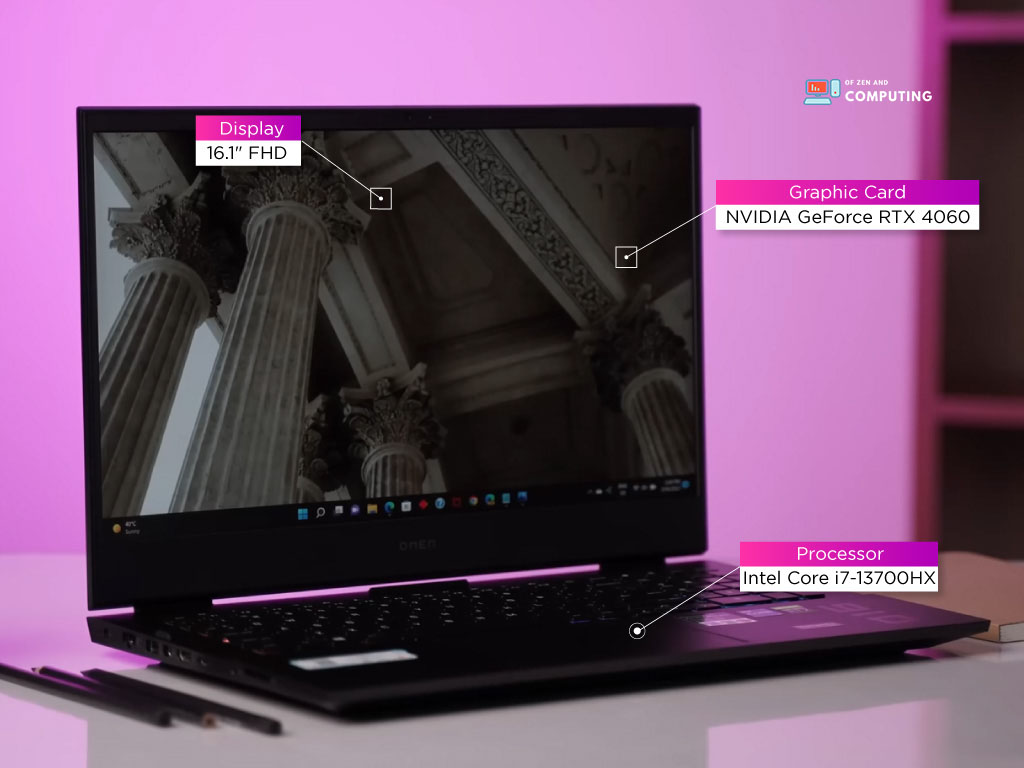
Screen: 16.1″ FHD | CPU: Intel 16-Core i7-13700HX | Graphics: NVIDIA GeForce RTX 4060 8GB GDDR6 | RAM: 64GB (32GB x 2) DDR5 | Storage: 2TB PCIe NVMe SSD | Ports: 2 x Thunderbolt 4 with USB Type-C 40 Gbps signaling rate, USB 3.2 Gen 1.0 Type-A 5 Gbps signaling rate, USB 3.2 Gen 1.0 Type-A 5 Gbps signaling rate, RJ-45, HDMI 2.1 output, AC Smart pin adapter plug; Wi-Fi 6E (2×2) + Bluetooth 5.3 | Speaker: Bang & Olufsen Dual speakers | Weight: 5.40 Pounds
If you’re on the lookout for a powerhouse gaming laptop featuring an Intel 16-core processor and the NVIDIA GeForce RTX 4060, then the HP OMEN 16 could be a great fit.
Retailing at $1,699, it’s under the $2000 mark but offers up features comparable to its pricier counterparts.
Starting with its display, this laptop commands your attention with a 16.1″ FHD screen, providing crisp images that enhance your gaming experience.
It’s always been a treat for my eyes as I navigate my favorite games; the vibrant colors and sharp contrasts are impressive. The interior components are just as noteworthy, specifically with regard to performance.
Running on an Intel 16-Core i7-13700HX CPU, I’ve found it handles numerous tasks excellently without unnecessary lags or crashes, enabling me to enjoy seamless gaming sessions consistently.
The inclusion of the NVIDIA GeForce RTX 4060 graphics card boosts the already impressive performance, offering a stellar graphic display without stuttering or dropping frames.
When it comes to memory and storage space, HP OMEN shines brightly again with its generous allocation: A whopping 64GB DDR5 of RAM and 2TB of PCIe NVMe SSD storage.
From my experience using this machine, launching games and apps is swift, while storing mammoth-sized files hasn’t been an issue.
Its connectivity is solid, too. You get two USB Type-C ports capable of delivering up to 40 Gbps signaling rate thanks to Thunderbolt technology.
I’ve also been pleased by the addition of USB Type-A ports that offer up to a handy 5 Gbps signaling rate each.
No product is flawless, and HP OMEN makes no exception. While I consider it one of the best buys under $2000 due in part to its capabilities and features mentioned above, there seems to be one notable gripe among all buyers – Lousy customer service.
This is in relation to getting the proper warranty. While this won’t directly impact the actual laptop use, it’s something you want to be aware of if you’re considering purchasing because it can affect your peace of mind as a buyer.
Our Verdict
To wrap up, the HP OMEN 16 offers terrific performance and high-end features for less than $2000.
While the processor and graphics card combination promise smooth and immersive gaming experiences, the screen delivers sharp images that make gameplay enjoyable.
Connectivity options are sufficient for even demanding users, while its storage capacity should please everyone. Customer service issues aside, I’ve found this laptop to offer true value for gamers on a budget.
Pros And Cons
- Affordable Price
- Excellent Display
- Solid connectivity
- High-quality graphics
- Powerful processor
- Poor Customer Service
5. Alienware X17 R2
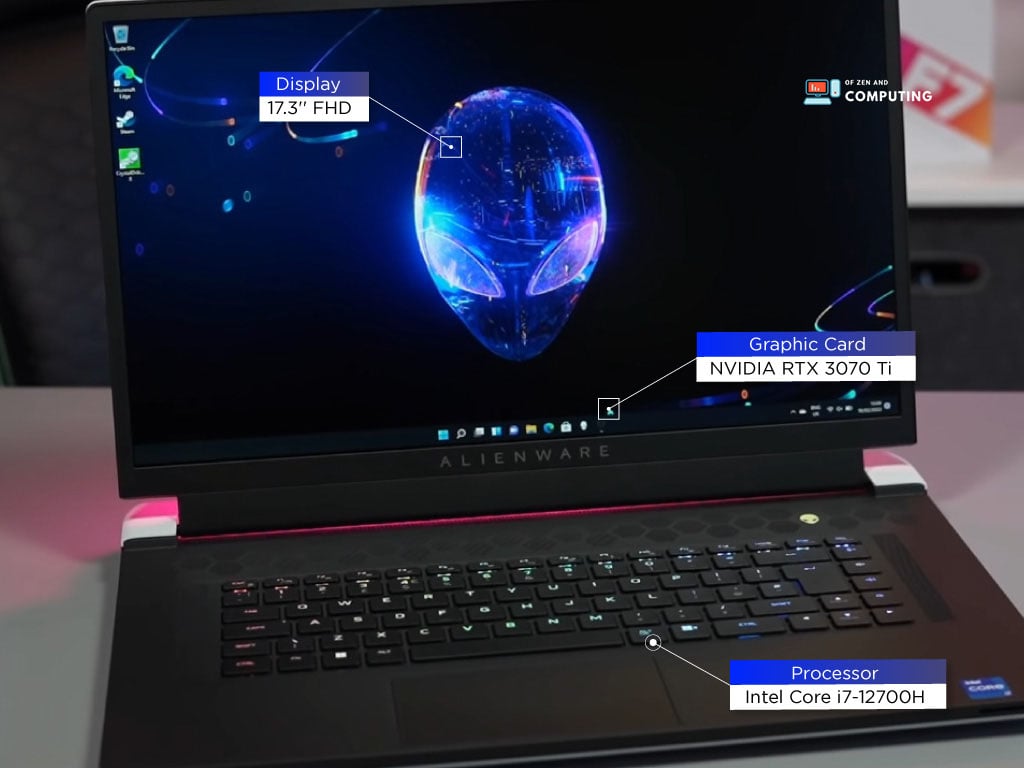
Screen: 17.3-inch FHD (1920×1080) 360Hz 300nits Display | CPU: Intel Core i7-12700H (24MB Cache, up to 4.6GHz, 8 cores) Processor | Graphics: NVIDIA GeForce RTX 3070 Ti | RAM: 16GB DDR4 3200MHz Memory | Storage: 1TB M.2 PCIe NVMe Solid State Drive and | Ports: 1 x Global headset jack, 1 x Type-C Thunderbolt 4/USB 3.2 Gen 2 Port, with Power Delivery (5V/3A), 2 x USB 3.2 Gen 1 Type-A with Power-share, 1 x Killer 3100 RJ-45 2.5G Ethernet, 1 x Type-C USB 3.2 Gen 2 Port,(5V/3A), 1 x HDMI 2.1, 1 x Micro SD, 1 x Mini Display 1.4, 1 x Power/DC-in Port | Speaker: 2 x 4W speakers | Weight: 7.05 pound
I’m always excited to pick up a new device, and the Alienware X17 R2 was no exception. Coming in at $1,927, this is a gaming behemoth that offers serious bang for your buck.
The rig’s design is just as striking as its performance, with a brilliant 17.3-inch FHD (1920×1080) display offering stunning visuals and an impressive refresh rate of 360Hz.
The heart of the Alienware X17 R2 is powered by an Intel Core i7-12700H CPU (with up to 4.6GHz and eight cores), which ensures smooth gameplay even in the most demanding gaming conditions.
But let’s not forget about its graphics engine – it packs an NVIDIA GeForce RTX 3070Ti GPU, capable of providing eye-watering graphics detail.
Once I got into the swing of things, I decided to put my beloved X17 through some intensive gaming sessions with titles like Elden Ring and Deathloop, plus the new PC releases of God of War and Uncharted games. Guess what? The laptop withstood over twelve straight hours of gameplay with ease.
Now, here’s where most gaming laptops falter: overheating. So naturally, I had my reservations, given that this comes equipped with a strong hardware lineup.
The Alienware X17 R2 pleasantly surprised me! While there was some heat felt coming from the vents during heavy gameplay, it remained manageable and definitely did not warm up my keyboard area – as something many reviewers seem to suggest.
But it wasn’t all smooth sailing. Some users have faced difficulties right out of the box with booting problems due to potential issues with RAM or the motherboard — this strikes as extremely disappointing given the substantial cost attached to owning an Alienware X17 R2.
Now let’s talk about weight. At a bit over seven pounds (7.05 pounds to be precise), the Alienware is not the lightest laptop on the market. This can discourage those who prioritize portability.
However, remember, this is a gaming laptop. If you are looking for something to use at a stationary desk, then this could easily work for you.
Our Verdict
The Alienware X17 R2 offers serious power and impressive performance. Sure, it’s not perfect – it has its minor quirks like any other tech gadget and quality control needs to be strengthened.
When it works as it should, it delivers immersive graphics and pro-level gameplay that makes us overlook the occasional shortcomings.
Pros And Cons
- Powerful processor and GPU
- Screen provides excellent visuals
- Good thermal management
- Occasional booting problems
- Heavy weight
6. Sager NP7881D
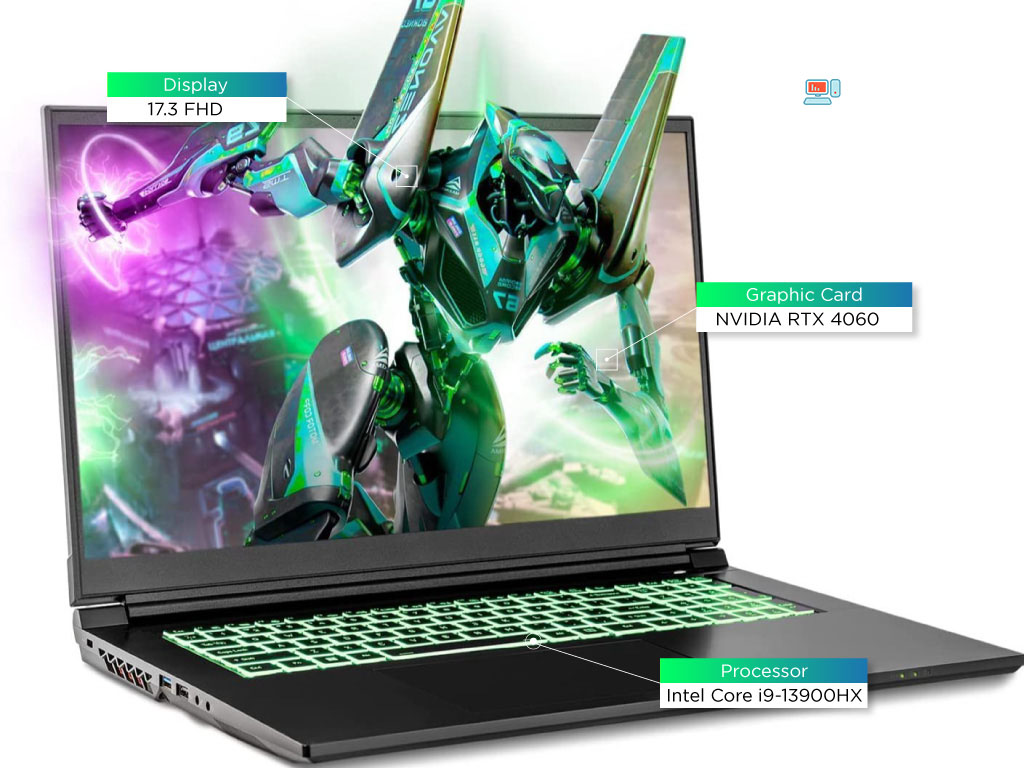
Screen: 17.3 FHD, CPU: Intel Core i9-13900HX, Graphics: NVIDIA RTX 4060, RAM: 32GB DDR5, Storage: 1TB SSD, Ports: SD Card reader, 1 Thunderbolt 4 Port (Type C), 1 HDMI Port, 1 USB 2.0 Port (Type A), 1 USB 3.2 Gen 1 Port (Type A), 2-in-1 3.5mm Jack, RJ-45 LAN, Speaker: 2 x 2w Blaster Studio, Weight: 6.28 pounds
Let me introduce you to the Sager NP7881D, a machine worth considering if you’re scouting for the best gaming laptops under $2000. Costing just $1549, it splashes impressive specs on the table that are hard to resist.
The most appealing aspect of this machine is undoubtedly its display. The 17.3-inch full HD screen is a delight to feast your eyes on when gaming or binge-watching Netflix.
It offers sharp details and color reproduction that adds vivacity to your experience.
Underneath its neat, minimalist design, the Sager NP7881D houses an Intel Core i9-13900HX processor complemented by an NVIDIA RTX 4060 graphics card.
This combination churns out an irresistible power that will sail through any game or creative task, like cutting butter with a hot knife.
What more can you add? Well, yes! A whopping 32GB DDR5 RAM ensures smooth multitasking and diminished loading times. Paired with a speedy 1TB SSD, transferring huge game files becomes quicker than ever.
As far as connectivity goes, this laptop has got you all covered – from the SD Card reader and Thunderbolt 4 port (Type C), HDMI port, USB ports, headphone jack to RJ-45 LAN port – it’s all there.
Even better is it comes equipped with dual high-quality speakers for a wholesome gaming experience.
One thing I must mention: the laptop does bear some weight at 6.28 pounds, which might not be ideal for someone constantly on the move.
There’s no denying that I am madly in love with this machine, but let’s hear from some other folks who use them daily:
Positive vibes come from users exclaiming their satisfaction regarding the technical specs, offering great value at such an affordable price.
They also seem pretty satisfied with how beautifully games run, even at the highest graphics settings.
There have been some mentions of issues with Windows 11 causing crashes. Luckily, switching to Windows 10 seems to solve it. Another slight hiccup mentioned is the fan, which tends to get loud and can cause some heating issues.
Our Verdict
The Sager NP7881D delivers stellar performance at a reasonable price bracket. It’s food for thought if you are in search of a high-performing gaming laptop under $2000 but don’t mind bearing a bit of extra weight.
Pros And Cons
- Stellar performance
- Excellent display
- Plenty of storage and RAM
- Might be slightly heavier for some
- The fan can get loud.
7. ASUS TUF F15
Screen: 15.6” Full HD (1920 x 1080) IPS Type Display 300Hz 3ms | CPU: Latest 12th Gen Intel Core i7-12700H Processor – 24M Cache, up to 4.7GHz, 14 cores (6 P-cores and 8 E-cores) | Graphics: NVIDIA GeForce RTX 3060 6GB GDDR6 – Boost up to 1752MHz at 140W (115W + 25W with Dynamic Boost) | RAM: 16GB DDR5 4800MHz RAM | Storage: 1TB PCIe NVMe M.2 SSD | Ports: 3x USB 3.2 Gen 1 Type-A, 1 x HDMI 2.0b, 1x Thunderbolt 4, 3.5mm Combo Audio Jack, 1 x RJ-45 | Speaker: 2 x 4W speakers | Weight: 5.51 Pounds
The ASUS TUF F15. This gaming laptop is a beast that packs quite a punch without hitting too hard on your wallet, priced at just $1,099.
Don’t be fooled by the price tag, though, because this machine is stacked with some killer specs that will give any hardcore gamer a run for their money.
Starting with the display, this laptop sports a 15.6” Full HD IPS type display with a 300Hz refresh rate and just a 3ms response time. This is ideal for fast-paced games where every second counts.
I’ve used it extensively since mid-June of 2022, and its performance has mesmerized me every time. The screen has minimal bleeding and offers decent color accuracy and brightness levels.
Powering the ASUS TUF F15 is the latest 12th Gen Intel Core i7-12700H processor, alongside the NVIDIA GeForce RTX 3060 high-performance graphic card, which delivers outstanding performance for gaming and multitasking alike.
This monster machine also impresses with a massive 16GB DDR5 RAM and massive 1TB PCIe NVMe M2 SSD storage.
One downside that I found on this model was regarding its graphics driver updates, which rendered my screen’s color accuracy as well as brightness inaccurate upon update, but reverting back to an older version solved the problem.
Now shifting focus to its keyboard & touchpad setup – they’re very nicely organized with comfortable key travel distance and tactility.
The built-in RGB lighting creates an impressive ambiance even though it doesn’t support per-key RGB lighting.
The ASUS TUF F15 does heat up a bit during intensive gaming sessions, but it’s bearable considering its powerful specification lineup.
There was also an initial issue with my unit’s microphone that was fixed after reinstalling audio drivers through My Asus software, indicating great self-regulated support.
With all the positives, there are some negatives, too; for instance, the GPU failed after a year of use, and the issue persisted even after driver updates.
Also, I have encountered difficulties contacting Asus support, specifically when it came to figuring out how to input the “@” sign using their suggested FN2 method.
Yet, reflecting on my overall experience with this laptop, it seems like a worthwhile purchase.
The ASUS TUF F15 couples exceptional capability with affordability, which makes it an appealing choice for gamers. With slight heating and some minor technical hiccups in mind, still – game on!
Our Verdict
My verdict is that the ASUS TUF F15 is undoubtedly amongst the best gaming laptops under $2000 you can get right now, considering its stature and capabilities outweighing its minute shortcomings.
Pros And Cons
- Great Screen Display
- Massive Storage & RAM
- High-performance Graphic Card
- Powerful Processor
- Inefficient Customer Support
- Inconvenient Heating Issue
8. MSI Rainbow 6
Screen: 15.6″ QHD, Anti-Glare Wide View Angle 165Hz 2.5ms DCI-P3 100% | CPU: Intel Core i7-12700H 14Core(6+8), 1.7-4.7GHz | Graphics: NVIDIA GeForce RTX 3070 Laptop GPU 8GB GDDR6 | RAM: 16GB (8G*2) DDR4 3200MHz | Storage: 1TB NVMe SSD Gen4x4 | Ports: 1x USB 3.2 Gen 1 Type-A, 1x USB 2.0 Type-A, 1 x HDMI, 1x USB 3.2 Gen 1 Type-C, 3.5mm Combo Audio Jack, 1 x RJ-45 | Speaker: 2 x 4W speakers | Weight: 7.4 pounds
In the realm of heavy-duty gaming laptops, I’ve been lucky enough to get my hands on some impressive machines. One that stands out from the crowd is the MSI Rainbow 6.
Priced at a reasonable $1,459, this beast comes packed with some seriously impressive specs that make it an excellent choice for any gamer looking to invest in a stellar piece of equipment.
Let’s first talk about my experience with its wide-view QHD display. It boasts a sizeable 15.6″ screen, which, in my conviction, seemed just about perfect for immersive gaming sessions.
The screen sprouts vibrant color profiles and swift refresh rates due to its Anti-Glare feature coupled with a 165Hz 2.5ms DCI-P3 100%.
Unraveling the heart of the machine under the hood, it’s powered by none other than an Intel Core i7-12700H 14 Core CPU clocking speeds between 1.7–4.7GHz.
It is supported by NVIDIA GeForce RTX 3070 Laptop GPU boasting an admirable 8GB GDDR6 graphics memory.
The combination of these cutting-edge CPUs and GPU bred pretty nifty performance during my gameplay: no lags or glitches to report on this front!
The MSI Rainbow accommodates an ample serving of RAM: a full 16GB DDR4 ticking at 3200MHz speed along with par excellence storage space due to its colossal onboard – yes, you heard it right – a whopping full terabyte NVMe SSD Gen4x4! Never fear running out of reach while storing those gigantic game files any longer!
The cavalcade ports encompassed in this model include two USB Type-As (One being gen1 and another Gen2), one HDMI input, one USB Type-C Gen1, and even an RJ-45 port.
So, whether it’s hooking up your keyboard mouse or even using an ethernet cable for uninterrupted connectivity, the Rainbow 6 has got it covered.
The speakers on the MSI Rainbow 6 were decent but not extraordinary. They are rated at 2 x 4W, which is perfectly fine for casual gaming and multimedia consumption.
In terms of weight, this impressive machine tips the scales at 7.4 pounds. While this might seem hefty to lug around, I feel that the power pack performance more than justifies the weight factor.
Now, let’s veer towards certain challenges that I experienced during my usage period. The first issue that popped up was a single dead pixel on the screen panel – this was a bit of disappointment for me, considering MSI’s stellar reputation in maintaining quality standards.
However, customer support was prompt, and they issued a replacement unit that I’m currently awaiting.
Another trade-off with such high-performance units like the MSI Rainbow 6 is their hardworking cooling system, which subsequently results in considerable noise levels.
But if you’re gaming with a solid pair of headphones (which most gamers do), this should pose no problems whatsoever.
Our Verdict
To sum up, the MSI Rainbow 6 is indeed a gamer’s delight, serving up top-of-the-line specs backed by magnificent performance output.
Its minor contrarieties are but small hitches in an otherwise smooth ride. The balance between price and features delivered by this machine makes it one heck of a steal!
Pros And Cons
- Incredible Performance
- High refresh rate display
- Adequate RAM + spacious storage
- Minor quality control issues
- Noticeable fan noise
9. Lenovo LOQ
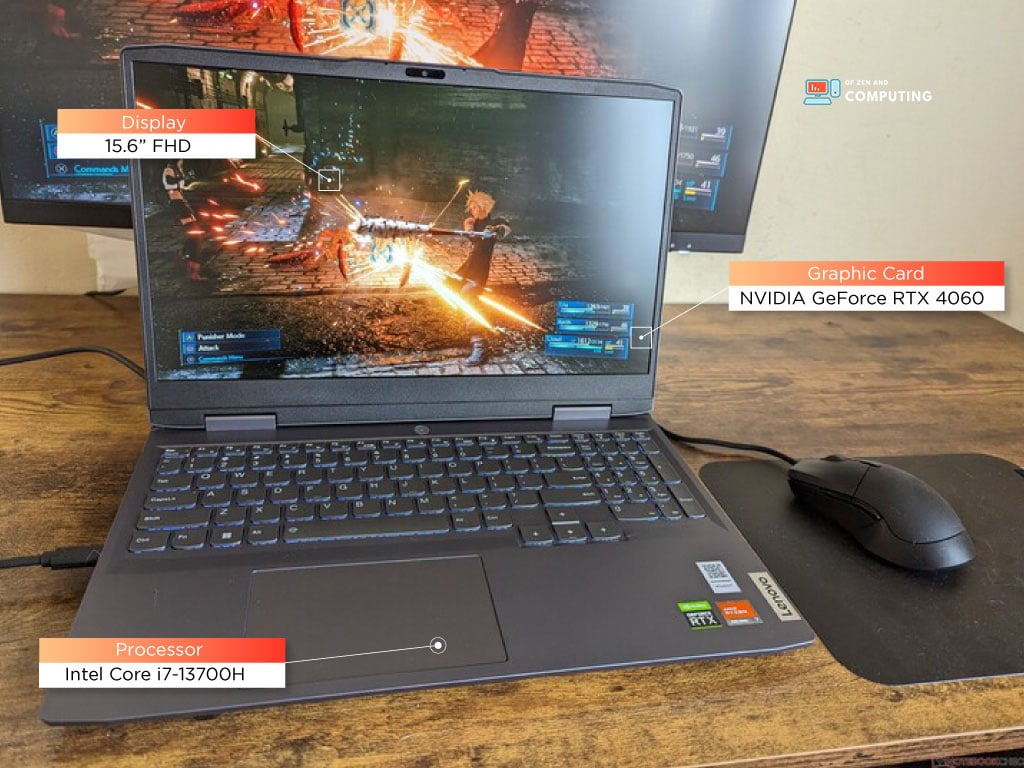
Screen: 15.6” FHD, CPU: Intel Core i7-13700H, Graphics: NVIDIA RTX 4060, RAM: 32 GB DDR5, Storage: 1 TB SSD, Ports: 1 x USB Type-C, 1 x Audio Combo Jack, 1 x USB Type-A 3.2 Gen1, 1 x E-Shutter Button, 1 x DC-in, 1 x RJ45, 2 x USB Type-A 3.2 Gen2, 1 x HDMI 2.1; Wi-Fi 6 and Bluetooth, Weight: 5.50 pounds
Tucked under a price tag of $1,318, the Lenovo LOQ is right on the money for those looking for a robust gaming experience without breaking the bank.
Let me share my journey exploring this laptop’s awesome features, which lead me to believe it’s a solid contender in the sub-$2000 category.
I am starting with visuals first because graphics are everything for gamers, right? The Lenovo LOQ houses a 15.6″ Full HD Screen that truly brings my games to life.
Whether it was shooting down enemies or racing through intricate landscapes, I enjoyed vivid and sharp images all throughout.
The build itself, though plastic, doesn’t feel cheap at all. Its simplicity is elegant – sturdy but not overly flashy. It wasn’t distracting during my marathon gaming sessions, nor did it feel like it would fall apart any minute.
Underneath its plain exterior sits the beastly Intel Core i7-13700H CPU coupled with NVIDIA RTX 4060 Graphics and a whopping 32GB DDR5 RA.
Remember Star Citizen? Yeah, that resource hog didn’t stand a chance. Everything ran pretty smoothly, which left me pleasantly surprised.
As for storage, we’ve got 1TB SSD sitting neatly, providing ample room for all my games, plus some extra space to spare for anything else.
The Lenovo LOQ doesn’t skimp on ports either – it’s truly generous in that department.
With multiple USB Type-A ports of different generations and an HDMI outlet, I had no trouble connecting my peripherals or displaying gameplay on external screens.
Moreover, the presence of Wi-Fi 6 and Bluetooth provided fast wireless connectivity around the clock, aiding seamless multiplayer action in real-time without any noticeable lag.
As fabulous as it sounds, though, you should know upfront about one downside I found out from another user – its weight. It’s bulky at 5.5 pounds and might not be the first choice for those always on the move.
Our Verdict
For avid gamers seeking an affordable solution to high-end gaming performance, this laptop is a steal! It’s got power, visual prowess, and impressive connectivity options.
If portability is a priority over gaming performance, you might want to consider other options.
Pros And Cons
- Robust performance
- Smooth gameplay
- Generous connectivity
- Bulky design can sacrifice portability
10. Acer Predator
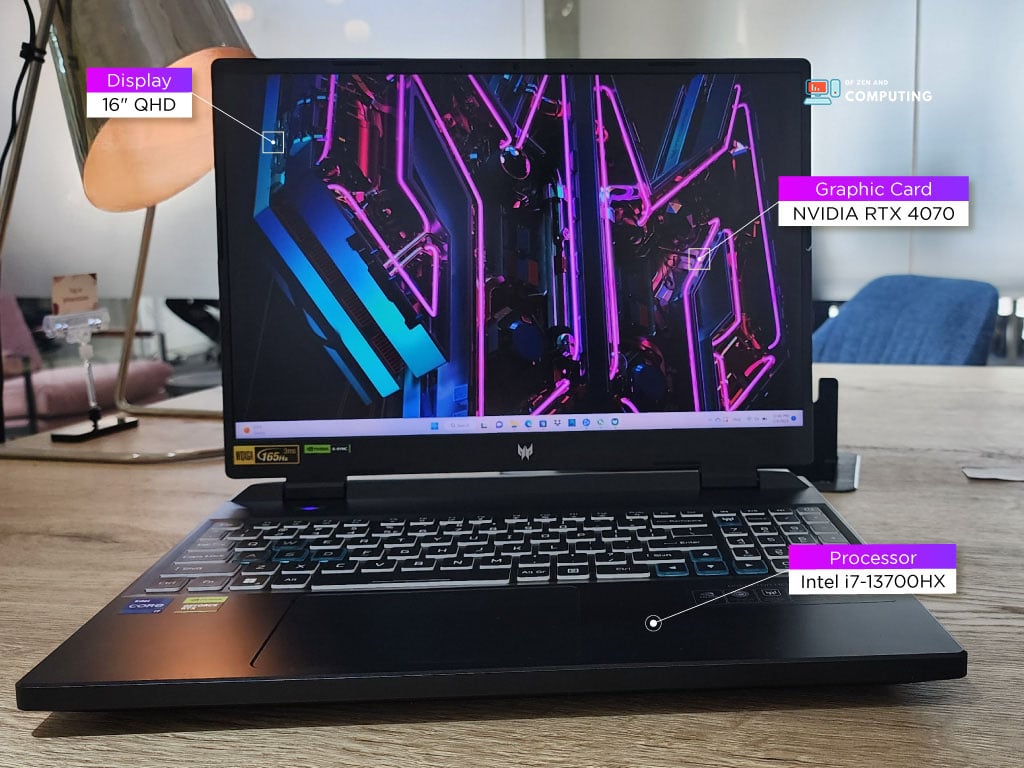
Screen: 16″ QHD | CPU: Intel i7-13700HX | Graphics: NVIDIA RTX 4070 | RAM: 16GB DDR5 | Storage: 1TB Gen 4 SSD | Ports: 2 x USB 3.2 Gen 2 Type-C Ports, Thunderbolt 4, 3 x USB 3.2 Gen 1 Type-A Ports, HDMI 2.1, Headphone/Speaker/Line-out Jack, Ethernet (RJ-45) | Speaker: 2 x Stereo | Weight: 5.73 pounds
Gaming laptops are all about power, portability, and performance, but what if I told you that there’s one that encapsulates these three attributes perfectly? Well, the Acer Predator Helios is exactly that.
Sporting an impressive Intel i7-13700HX CPU and an NVIDIA RTX 4070 GPU, the Acer Predator Helios provided me with a smooth gaming experience, performing at peak level without any noticeable lag even when running intensive AI programs consistently.
In terms of performance metrics, it had a similar consistency to my desktop with an RTX3080.
Acer has done a fantastic job with the design of the Helios. The 16-inch QHD screen provides stunning visuals, which makes my gaming experience more immersive.
Even though this device is slightly heavier at around 5.73 pounds, its LED keyboard color options lend some eye-catching aesthetics to its overall look.
The laptop comes loaded with Windows 11, which made it a bit tricky for me initially, as it asked quite a few questions and took multiple decisions every time I booted. Once you get past the initial setup, it offers advanced computing capabilities.
Our Verdict
This machine surpassed all my expectations in terms of performance or thermal management courtesy of its impressive cooling system. However, it does struggle sometimes when connecting to Wi-Fi, but a few restarts normally solve this issue.
Pros And Cons
- Superb Performer
- Brilliant Display
- Impressive Cooling System
- Colorful LED Keyboard
- Heavier Than Average
- The complexity of Windows 11
- Wi-Fi Connectivity Issues
Buying Guide: The Best Gaming Laptops Under $2000
Have you ever thought about upgrading your gaming experience, but your wallet begged to differ? Well, you don’t necessarily have to break the bank for top-tier gaming performance.
Think of high frame rates, spectacular graphics, and lightning-fast load times – all within an affordable package! This guide will take you through some of the best gaming laptops under $2000 that pack enough power to make your gaming dreams come true.
CPU
The beating heart of any laptop is its central processing unit (CPU). This powerful chip fuels all functions, from simple tasks like opening a web browser to complex processes like running high-intensity games. If you’re serious about a top-notch gaming experience, you’ll need a laptop with an equally superb CPU.
You might be wondering – how important is the CPU for real-life gaming? A lot more than it seems! A cutting-edge CPU ensures smooth-out performance during heavy gameplay.
Suppose your game involves intense battles or rapid movements on screen, a fast and effective CPU can mean the difference between victory and defeat! It allows for smoother multitasking, too – because who doesn’t Spotify their epic game sessions?
GPU
Complimenting the mighty CPU is the graphics processing unit or GPU. Imagine this – You’ve just purchased a brand-new action-packed game with fantastic graphics.
But opening it up on your laptop presents you with choppy images and poor rendering! Enter GPU – the unsung hero responsible for rendering high-quality images on your screen.
Your GPU has one job – delivering clean, crisp graphics quickly enough that they appear continuous to the human eye. Anything that involves visuals runs through this vital piece of hardware first!
As a gamer, you should be aiming for a dedicated GPU instead of an integrated one. Nvidia’s GeForce RTX 30 or 40 series graphics cards are prime examples – offering excellent performance for modern games, right at your fingertips.
RAM
Even with high-end CPUs and GPUs, any gaming laptop would fall short without enough Random Access Memory (RAM). RAM is likened to the short-term memory of your computer – it temporarily stores all the files your device needs right now and in the future.
When you’re deep into an online multiplayer battle or exploring vast open-world games, you certainly don’t want to experience jerky movements or suddenly find yourself stuck amidst gameplay. Here’s where RAM steps up – it keeps data ready for instant access, thus maintaining overall system speed.
For gaming laptops under $2000, we recommend a bare minimum of 16GB of RAM. Better yet, opt for 32GB if possible. With enough RAM in your arsenal, your games will run smoothly and quickly – exactly the way you want them!
Storage
When it comes to gaming laptops, we can’t stress enough about the importance of quality storage. Ever notice how your game takes forever to load? That’s because your storage drive is hard at work.
For players who fancy large-scale games that take up significant space or those who have a library of favorite games they enjoy playing alternately – investing in a proper storage system is crucial.
One recommended specification for gaming powerhouses under $2000 is at least a 512GB solid-state drive (SSD).
SSDs are known to have faster read and write times than traditional hard disk drives (HDD), thus resulting in quicker load times for games. If you really don’t want any compromise on loading times, go for 1TB or even 2TB SSD.
Display
You are moving onto the most visible appeal of a gaming laptop – the display. Dynamic lighting, vibrant colors, and fast action scenes should come to life seamlessly on your computer screen.
The display can drastically affect your immersion and overall enjoyment while gaming.
For the ideal gaming experience, look for laptops featuring at least a 15-inch display with a 144Hz refresh rate to keep motion clips fluent without any stutters.
Higher resolution provides greater detail in textures and shadows, so if possible, aim for Full HD (1920 x 1080) resolution screens or higher. Remember – ‘The more pixels, the more immersive gameplay.’
Ports
The number and variety of ports included in your laptop empowers you with enhanced flexibility.
HDMI ports enable you to connect an external monitor or TV, while multiple USB ports allow you to hook up essential peripherals like headset, mouse, or keyboard.
At least one USB Type-C port is also highly advised as it supports faster data transfer speeds and can also double as a video output source.
Some even deliver power over this port – talk about multi-tasking! An SD card reader can come in handy for quickly accessing extra storage or transferring game files.
Wireless Connectivity
When you’re deep in multiplayer games or live streaming, the last thing you need is a weak Wi-Fi signal. Wireless connectivity plays an essential role in providing uninterrupted gaming sessions.
Look for laptops that support the latest Wi-Fi 6 standard, which offers the fastest wireless connection and is able to handle more traffic at faster speeds.
Bluetooth connectivity is also beneficial, making it easy to connect wireless peripherals like gaming controllers, headsets, and more.
Battery Life
While less of a consideration for gamers who usually stay plugged in, battery life still matters. Sometimes, power outlets aren’t an option on the go – be it during travel or when you want to game on your comfy couch.
For gamers looking for unplugged playtime, choose a laptop with more than 5 hours of battery life. This ensures your device won’t conk out in the middle of play when you’re away from a power source.
After all, powerful gaming components can drain the battery rapidly – and nothing cuts fun shorter than losing power in a heated gaming moment!
Conclusion
The best gaming laptops under $2000 offer the perfect balance of power and portability. If you’re looking for a machine that can handle the most demanding games without weighing you down, any of the laptops on this list would be a great choice.
In the end, it all comes down to personal preference. Do you value raw power over portability? Are you willing to sacrifice some graphics quality for a lower price? With so many great options available, there’s sure to be a gaming laptop out there that’s perfect for you.











